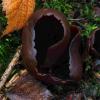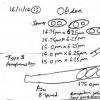
07-12-2025 16:07
Arnold BüschlenHallo, ich habe in einer Moos-Aufsammlung (epiphy

08-12-2025 21:04
Mark Stevens"Hello everyone,I'm relatively new to microscopy (

09-12-2025 12:06
 Andgelo Mombert
Andgelo Mombert
Bonjour,Je recherche l'article concernant Hypobryo

08-12-2025 18:59
 Lothar Krieglsteiner
Lothar Krieglsteiner
.. found by a seminar-participant, I do not know t

08-12-2025 17:37
 Lothar Krieglsteiner
Lothar Krieglsteiner
20.6.25, on branch of Abies infected and thickened

16-03-2014 22:00
Hello,I found this species a few months ago but ha

08-12-2025 13:39
Thomas Læssøehttps://svampe.databasen.org/observations/10572899
Otidea umbrina ? Dark Brown Throughout
Peter Thompson,
27-11-2014 10:16
I recently collected a fruit body of a large cup fungus, which was deeply split down one side. It seems that the genus Otidea is most likely, and the closest species which I can find seems to be O. umbrina. Using Nicolas Van Vooren's key to Otidea, my sample also looks closest to O. umbrina.
The fruit bodies were moist and looked fresh when found, so I assume that dark brown hymenium and exterior are correct. The exterior is quite smooth, unlike that of O. bufonia.
The substrate is moss covered rotting wood of Salix.
I have attached a photo of the fruit bodies (very compressed, causing pinkish and greenish tones which were not on the fruit body itself).
The microscopy is also attached.
I wonder if I have identified it correctly?
Thank you,
With Best Wishes,
Peter.
Nicolas VAN VOOREN,
01-12-2014 07:56

Re : Otidea umbrina ? Dark Brown Throughout
In my opinion, this is Otidea bufonia. O. umbrina is a synonym.
Peter Thompson,
02-12-2014 10:05
Re : Otidea umbrina ? Dark Brown Throughout
Hello Nicolas,
Thank you for your reply.
I must admit to being confused now.
When I worked through your Otidea key (Dec. 2008), I selected as the best options:
1 (b) split down one side = 3.
Then 3 (c) dark brown colour = 11.
Then 11 (b) without violaceous tinges = 13.
Then 13 (b) without olivaceous tinges = 15.
Then 15 (b) paraphyses with simple apex = 17.
Then 17 (b) apothecia high, deep, dark coloured = O. umbrina.
When I considered O. bufonia, I did not see any folding of the excipulum on my sample, but quite a smooth surface, at most coarsely granulate. Also no olivaceous colouring of the hymenium.
Since the 2008 key, have the species been redefined? Is there a new key to use?
Thank you,
With Best Wishes,
Peter.
Thank you for your reply.
I must admit to being confused now.
When I worked through your Otidea key (Dec. 2008), I selected as the best options:
1 (b) split down one side = 3.
Then 3 (c) dark brown colour = 11.
Then 11 (b) without violaceous tinges = 13.
Then 13 (b) without olivaceous tinges = 15.
Then 15 (b) paraphyses with simple apex = 17.
Then 17 (b) apothecia high, deep, dark coloured = O. umbrina.
When I considered O. bufonia, I did not see any folding of the excipulum on my sample, but quite a smooth surface, at most coarsely granulate. Also no olivaceous colouring of the hymenium.
Since the 2008 key, have the species been redefined? Is there a new key to use?
Thank you,
With Best Wishes,
Peter.


